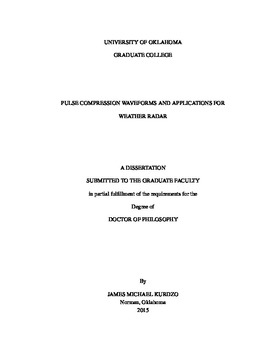| dc.contributor.advisor | Palmer, Robert | |
| dc.contributor.author | Kurdzo, James | |
| dc.date.accessioned | 2015-12-07T19:31:47Z | |
| dc.date.available | 2015-12-07T19:31:47Z | |
| dc.date.issued | 2015-12-18 | |
| dc.identifier.uri | https://hdl.handle.net/11244/23250 | |
| dc.description.abstract | The progression of phased array weather observations, research, and planning over the past decade has led to significant advances in development efforts for future weather radar technologies. However, numerous challenges still remain for large-scale deployment. The eventual goal for phased array weather radar technology includes the use of active arrays, where each element would have its own transmit/receive module. This would lead to significant advantages, however, such a design must be capable of utilizing low-power, solid-state transmitters at each element in order to keep costs down. In order to provide acceptable sensitivity, as well as the range resolution needed for weather observations, pulse compression strategies are required. A robust optimization technique for pulse compression waveforms with minimalistic windowing using a genetic algorithm is presented. A continuous nonlinear frequency modulated waveform which takes into account transmitter distortion is shown, both in theory and in practical use. Measured pulses and weather observations from the Advanced Radar Research Center's dual-polarized PX-1000 transportable radar, which utilizes dual 100-W solid-state transmitters, are presented. Development of waveform groups for increased isolation is presented as a proxy for multi-sector array design and spectral savings, and waveforms for convective storm observations and clear air observations during the PECAN project are discussed. A detailed analysis of the 20 May 2013 Moore, Oklahoma tornado is presented as an example of research-grade quality pulse compression weather data, including the characterization of rear flank gust front surges co-located with debris ejections. A failed occlusion hypothesis is discussed as a possible reason for a looping pattern at the Moore Medical Center. Numerous examples from the Atmospheric Imaging Radar (AIR) convective field program are also presented as examples of pulse compression capabilities. With a 20-deg vertical fan beam, the AIR is capable of volumetrically scanning a storm of interest in under 10 seconds at 1-deg by 1-deg by 30-m spatial resolution, but requires pulse compression for adequate sensitivity due to the wide transmit beam. This technique is used to analyze the tilting characteristics of two major spring 2015 tornadoes as well as other cases since 2012. | en_US |
| dc.language | en_US | en_US |
| dc.subject | Physics, Atmospheric Science. | en_US |
| dc.subject | Remote Sensing. | en_US |
| dc.subject | Engineering, Electronics and Electrical. | en_US |
| dc.title | Pulse Compression Waveforms and Applications for Weather Radar | en_US |
| dc.contributor.committeeMember | Cheong, Boon Leng | |
| dc.contributor.committeeMember | Havlicek, Joseph | |
| dc.contributor.committeeMember | Bluestein, Howard | |
| dc.contributor.committeeMember | Zhang, Guifu | |
| dc.date.manuscript | 2015-10-19 | |
| dc.thesis.degree | Ph.D. | en_US |
| ou.group | College of Atmospheric & Geographic Sciences::School of Meteorology | en_US |
